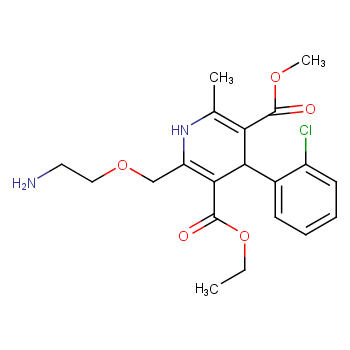 |
 |
(R)-3-ethyl 5-methyl 2 (R,S)-2-[(2-aminoethoxy)methyl]-4-(2-chlorophenyl)-3-ethoxycarbonyl-5-methoxycarbonyl-6-methyl-1,4-dihydropyridine 2-[(2-Aminoethoxy)methyl]-4-(2-chlorophenyl)-1,4-dihydro-6-methyl-3,5-pyridinedicarboxylic acid 3-ethyl 5-methyl Ester 2-[(2-aminoethoxy)methyl]-4-(2-chlorophenyl)-3-ethoxycarbonyl-5-methoxycarbonyl-6-methyl-1,4-dihydropyridine 3,5-Pyridinedicarboxylic acid, 2-((2-aminoethoxy)methyl)-4-(2-chlorophenyl)-1,4-dihydro-6-methyl-, 3-ethyl 5-methyl ester 3,5-Pyridinedicarboxylic acid, 2-[(2-aminoethoxy)methyl]-4-(2-chlorophenyl)-1,4-dihydro-6-methyl-, 3-ethyl 5-methyl ester 3,5-Pyridinedicarboxylic acid, 2-[(2-aminoethoxy)methyl]-4-(2-chlorophenyl)-1,4-dihydro-6-methyl-, 5-ethyl 3-methyl ester 3,5-pyridinedicarboxylicacid,1,4-dihydro-2-((2-aminoethoxy)methyl)-4-(2-chlor 3-ethyl 5-methyl ()-2-[(2-aminoethoxy)methyl]-4-(2-chlorophenyl)-1,4-dihydro-6-methyl-3,5-pyridine dicarboxylate 3-Ethyl 5-methyl 2-[(2-aminoethoxy)methyl]-4-(2-chlorophenyl)-6-methyl-1,4-dihydro-3,5-pyridinedicarboxylate 3-ethyl 5-methyl 2-[(2-aminoethoxy)methyl]-4-(2-chlorophenyl)-6-methyl-1,4-dihydropyridine-3,5-dicarboxylate 3-Ethyl 5-methyl 2-{[(2-aminoethyl)oxy]methyl}-4-(2-chlorophenyl)-6-methyl-1,4-dihydropyridine-3,5-dicarboxylate 3-ethyl-5-methyl-(4RS)-2-[(2-aminoethoxy)-methyl]-4-(2-chlorophenyl)-6-methyl-1,4-dihydropyridine-3,5-carboxylate benzene sulphonate 3-ethyl5-methylester 5-Ethyl 3-methyl 2-[(2-aminoethoxy)methyl]-4-(2-chlorophenyl)-6-methyl-1,4-dihydro-3,5-pyridinedicarboxylate Amlocard AMLODIPINE BASE Amlodipine base (crystalline) Amlodipino Amlodipinum Amlodipinum [Latin] Amlodis Coroval Istin Lipinox LOTREL methyl ethyl 2-(2-aminoethoxymethyl)-4-(2-chlorophenyl)-6-methyl-1,4-dihydropyridine-3,5-dicarboxylate MFCD00864687 Norvasc T6M DHJ B1O2Z CVO2 DR BG& EVO1 F1 UNII:1J444QC288
The Amlodipine with the cas number 88150-42-9, is also called (1)3-Ethyl-5-methyl ( -)-2-((2-aminoethoxy)methyl)-4-(2-chlorphenyl)-1,4-dihydro-6-methyl-3,5-pyridindicarboxylat ; (2)3-Ethyl-5-methyl ( -)-2-((2-aminoethoxymethyl)-4-(o-chlorophenyl)-1,4-dihydro-6-methyl-3,5-pyridinedicarboxylate ; (3) Amlocard ; (4) Amlodipine ; (5) Amlodipino ; (6) Amlodipinum ; (7) Amlodis ; (8) Amlor ; (9) Coroval ; (10) Lipinox ; (11) Norvasc. It belongs to the following product categories: (1)Active Pharmaceutical Ingredients; (2)Dihydropyridine Class Chemicals; (3)Intermediates & Fine Chemicals; (4)Pharmaceuticals; (5)Calcium channel
Properties of Amlodipine are: (1)ACD/LogP: 4.16 ; (2)# of Rule of 5 Violations: 0 ; (3)ACD/LogD (pH 5.5): 1.23 ; (4)ACD/LogD (pH 7.4): 2.64 ; (5)ACD/BCF (pH 5.5): 1 ; (6)ACD/BCF (pH 7.4): 26.11 ; (7)ACD/KOC (pH 5.5): 5.14 ; (8)ACD/KOC (pH 7.4): 133.65 ; (9)#H bond acceptors: 7 ; (10)#H bond donors: 3 ; (11)#Freely Rotating Bonds: 11 ; (12)Polar Surface Area: 68.31??2 ; (13)Index of Refraction: 1.545 ; (14)Molar Refractivity: 105.41 cm3 ; (15)Molar Volume: 333 cm3 ; (16)Polarizability: 41.79 ×10-24cm3 ; (17)Surface Tension: 44.4 dyne/cm ; (18)Density: 1.227 g/cm3 ; (19)Flash Point: 272.6 °C ; (20)Enthalpy of Vaporization: 80.17 kJ/mol ; (21)Boiling Point: 527.2 °C at 760 mmHg ; (22)Vapour Pressure: 3.34E-11 mmHg at 25°C
The Amlodipine appears to be Yellow Solid. It is used as an anti-hypertensive and in the treatment of angina because it is a long-acting calcium channel blocker. Seemimg Like other calcium channel blockers, Amlodipine reduce blood pressure by relaxing the smooth muscle in the arterial wall, decreasing peripheral resistance. Besides, it increases blood flow to the heart muscle in angina. Adverse effcts include common headache, fatigue, insomnia, edema, abdominal pain, nausea, dizziness, palpitation and red face. Rare rash, itching, expiratory dyspnea, muscle spasm and indigestion. Rarely have myocardial infarction and chest. It can have edema, headache, dizziness, weakness, etc.
The Amlodipine can react with nicotinic acid to obtain 4-(2-chloro-phenyl)-2-methyl-6-{2-[(pyridine-3-carbonyl)-amino]-ethoxymethyl}-1,4-dihydro-pyridine-3,5-dicarboxylic acid 5-ethyl ester 3-methyl ester.
Reaction condition is CH2Cl2 as solvent under ambient temperature for 16 hour(s). Yield is 57 %.
?????????????????
?
You can still convert the following datas into molecular structure :
1. SMILES: Clc1ccccc1C2C(=C(/N/C(=C2/C(=O)OCC)COCCN)C)\C(=O)OCCopyCopied
2. InChI:?InChI=1/C20H25ClN2O5/c1-4-28-20(25)18-15(11-27-10-9-22)23-12(2)16(19(24)26-3)17(18)13-7-5-6-8-14(13)21/h5-8,17,23H,4,9-11,22H2,1-3H3
The Amlodipine toxic data can be showed in the following sheet.
?
| Organism | Test Type | Route | Reported Dose (Normalized Dose) | Effect | Source |
|---|---|---|---|---|---|
| child | TDLo | oral | 400ug/kg (0.4mg/kg) | VASCULAR: BP LOWERING NOT CHARACTERIZED IN AUTONOMIC SECTION | American Journal of Emergency Medicine. Vol. 18, Pg. 581, 2000. |
| women | LDLo | oral | 1400ug/kg (1.4mg/kg) | CARDIAC: PULSE RATE INCREASE WITHOUT FALL IN BP VASCULAR: BP LOWERING NOT CHARACTERIZED IN AUTONOMIC SECTION |
Journal of Toxicology, Clinical Toxicology. Vol. 33, Pg. 253, 1995. |
| women | TDLo | oral | 600ug/kg/3D-I (0.6mg/kg) | SENSE ORGANS AND SPECIAL SENSES: OTHER CHANGES: OLFACTION BLOOD: HEMORRHAGE BLOOD: THROMBOCYTOPENIA |
Annals of Pharmacotherpy. Vol. 33, Pg. 1126, 1999. |
Acute toxicity - Oral, Category 3
Serious eye damage, Category 1
Specific target organ toxicity \u2013 repeated exposure, Category 2
Hazardous to the aquatic environment, short-term (Acute) - Category Acute 1
Hazardous to the aquatic environment, long-term (Chronic) - Category Chronic 1
| Pictogram(s) |     |
|---|---|
| Signal word | Danger |
| Hazard statement(s) | H301 Toxic if swallowed H318 Causes serious eye damage H373 May cause damage to organs through prolonged or repeated exposure H400 Very toxic to aquatic life H410 Very toxic to aquatic life with long lasting effects |
| Precautionary statement(s) | |
| Prevention | P264 Wash ... thoroughly after handling. P270 Do not eat, drink or smoke when using this product. P280 Wear protective gloves/protective clothing/eye protection/face protection. P260 Do not breathe dust/fume/gas/mist/vapours/spray. P273 Avoid release to the environment. |
| Response | P301+P310 IF SWALLOWED: Immediately call a POISON CENTER/doctor/\u2026 P321 Specific treatment (see ... on this label). P330 Rinse mouth. P305+P351+P338 IF IN EYES: Rinse cautiously with water for several minutes. Remove contact lenses, if present and easy to do. Continue rinsing. P310 Immediately call a POISON CENTER/doctor/\u2026 P314 Get medical advice/attention if you feel unwell. P391 Collect spillage. |
| Storage | P405 Store locked up. |
| Disposal | P501 Dispose of contents/container to ... |
none
 |
 |
Literatures:
MATRIX LABORATORIES LTD Patent: WO2006/3672 A1, 2006 ; Location in patent: Page/Page column 7 ;  Yield: ~90% |
 |